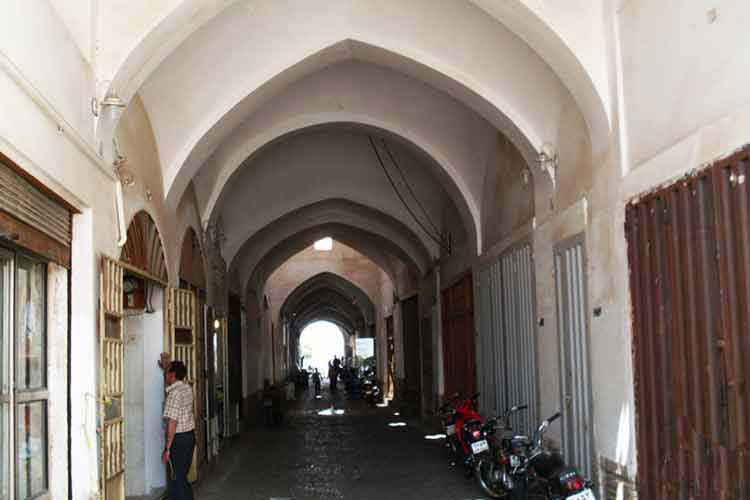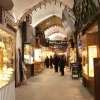The History of Bazaar
The bazaar is derived from the Pahlavi (old type of Persian) word Vakar which changed into bazaar through linguistic changes over time. If you look the word bazaar up in a dictionary you will find” a market or area where there are a lot of small shops, especially in India or the Middle East” and if you want to check the origin of this word, the dictionary says “Persian”. Bazaars are the economic pillar of cities since pre-Islamic era.
Yazd is an old and historic city and the first adobe city in the world, which has been on the route of the Silk Road. That is why presence of market and bazaar in this city is considered essential and vital. Bazaar has played a significant and strategic role in the historical context of Yazd.
A collection of Historical bazaars is built in the original Islamic – Iranian architectural style with beautiful minarets and badgirs (wind towers). These bazaars consist of several branches, Timchehs, Sarays, Mosques, Schools, Hosseiniyehs, Squares, Caravanserais, Ab anbars, workshops, which are still important and valuable for Iranian people. In addition to the commercial aspect, bazaars are also one of the fascinating and mostly visited attractions of Yazd.
These bazaars were divided into two parts of the Northern and Southern during the Pahlavi era with the construction of Shah Street (current Qiam St.). As a result, some of its main areas, such as Mohammad Ali Khan Bazaar, Panjeh Ali Bazaar, Orosiduz Bazaar (the shoe making market) and etc. were completely destroyed.
.jpg)
Bazaar Activity
Bazaars in Yazd grew and boomed from the fourth century AH. The rulers of the Salghurids, Kakuyids, Timurid dynasty and etc. expanded the city and developed the trade conditions, they also began to build other bazaars which were inside the old city and along the main road of the city. Of course, over the centuries, the location and conditions of the bazaars have changed as the city grew bigger and bigger.
These bazaars were a good place for selling old and traditional handicrafts. The main commodities traded in this market are gold, Yazdi sweets, textiles and carpets.
Some of the manufacturing workshops in the bazaar include a Mazariha workshop (Henna and Natural leaves grinding), a halva workshop (the place where Sesame is converted to Halva-Ardeh), and a dyeing workshop (a place for the coloring woolen and woolen fibers). Interestingly, each bazaar was designed dependent on its type of activity.
.jpg)
The Most Important Historical Bazaars in Yazd
Historical bazaars in Yazd includes Darvazeh Mehriz Bazaar, Tabrizian Bazaar, Zargari Bazaar, Panjeh Ali Bazaar, Mesgari Bazaar, Haji Qanbar Bazaar, Mohammad Ali Khan Bazaar dating back to the Zandy era, Qeysarie and the Khan Bazaar dating back to the thirteenth century. There are other historical bazaars in Yazd including Jafar Khan Bazaar belonging to the Zandy era with the registration number 7789, the Mirza Karim Bazaar for the Qajar period with the registration number 8528, Serajha Bazaar belonging to the eighth century, with the registration number 8525, Hazrat Abbasi Bazaar dating back to the Qajar era and with the registration number 7793, the Rismanian Bazaar belonging to first Pahlavi era, with the registration number 7790, which are all registered as national monuments.
Here, we briefly demonstrate some of these important historical bazaars:
.jpg)
Khan Bazaar
The Khan Bazaar dates back to the period of Naser al-Din Shah Qajar and with the length of 274 meters, height of 4 - 6 meters is the longest, widest, and most famous traditional bazaar in Yazd. It is considered as one of the old and most spectacular adobe places in Yazd. A hosseiniyeh, an ab anbar, and a hammam next to it were gradually built by Mohammad Taqi Khan Bafqi. Khan Square with the shops around, has ways to the Mullah Ismail Bazaar and the Qeysarie Bazaar.
The Khan complex consists of several branches, shops and numerous timchehs. Although each of these bazaars has a special name, today, all of them are known as the Khan Bazaar.
.jpg)
Some parts of Khan Bazaar in Yazd include Zargari Bazaar, Mullah Ismail Bazaar, Panjeh Ali Bazaar, Alaghebandi Bazaar belonging to late nineteenth-century with the registration number 7791, Kashigari Bazaar, Mesgarha Bazaar, Chitsazi Bazaar, Qeysarie Bazaar, Sadri (Shazdeh Fazel) Bazaar related to the late Qajar era with the registration number 8526, Darvazeh Mehriz Bazaar, and Afshar Bazaar related to the Qajar era with the registeration number 8542.
Khan Bazaar Collection was registered in the list of National Iranian Monuments in 2003 with registration no. 8544.
.jpg)
Haji Ghanbar Bazaar
Haji Ghanbar Bazaar is the oldest Bazaar in Yazd related to the 9th century AH which is referred to as a collection of shops below and around Amir Chakhmaq Takiyeh. This small bazaar was founded by one of the rulers named Haji Ghanbar in order to boost the economy, then in the thirteenth century AH some suspended tile work was added to its entree.
The Haji Ghanbar Bazaar in Yazd caused many different shops to be created and boom many other shops including the well-known Confectionery of Haj Khalife Rahbar.

Tabrizian Bazaar
This traditional bazaar is located at the end of the Panjeh Ali Bazaar belonging to Qajar era, which is 59 meters long, 5.3 meters wide, and 5.5 meters high. Each opening of this bazaar is approximately 4 meters wide with the area of 19.6 square meters. This bazaar is made of clay, mud, brick and gypsum, and with arched roof leading the eyes of the observer into a nice landscape.
.jpg)
Darvazeh Mehriz Bazaar
Darvazeh Mehriz Bazaar was built in the Qajar era and Mughal Empire with the length of 38 meters and width of 3.5 meters. The bazaar has 6 shops with an average opening of 5 meters, which is connected to Khan Bazaar from south and Dar al-Shifa Alley or Darvazeh Tarikhi from north.
Darvazeh Mehriz Bazaar was registered in the list of National Iranian Monuments in 2003 with registration no. 8543.
.jpg)
Zargari Bazaar
Zargari Bazaar (goldsmith) in Yazd with the length of 94 meters, width of 3 meters, and height of 6 meters belongs to the twelfth and thirteenth century AH. This bazaar is similar to Tabrizian Bazaar in terms of architecture style, having a high ceiling with arches and a lightwells sending light down to the bazaar.
The Zargari Bazaar of Yazd has 53 shops with famous and special 20-karats Yazdi gold, which, with its special glamor, strikes the eye of every passerby.
This market was also registered in 2003 in the list of National Iranian Monuments with registration no. 8527.
.jpg)
Qeysarie Bazaar
Qeysarie Bazaar of Yazd dates back to the end of the 12th century AH and is one of the five famous Iranian bazaars along with the historical bazaars of Shiraz, Isfahan, Kerman, and Qazvin.
In the past, the title Qeysarie was given to places which had some specific architectural characteristics, for example it was like a lane of Bazaar, a corridor, or a Saray, mostly in such bazaars they sell precious commodities and excellent textiles.
The Qeysarie Bazaar is located between Khan Square and Khan School. It is the most beautiful traditional bazaar. Its architectural style is much more beautiful than that of other bazaars because it is well-ordered and well-arranged. Shop owners usually sell local fabrics of Yazd here. The bazaar has a two-leaf wooden door. People enter and exit from the bazaar through these two precious doors.
Qeysarie Bazaar was registered in the list of National Iranian Monuments in 2002 with registration no. 7795.
.jpg)
Panjeh Ali Bazaar
The Panjeh Ali bazaar is known as Mesgari (Coppersmith) Bazaar in Yazd, which is 600 years old, belongs to the 9th century AH and still retains its old traditional context. The Mesgari Bazaar is located in Qiam Street, where various types of copper and metal products such as decorative crafts, kitchen utensils, and agricultural tools are being manufactured and sold.
The Mesgari Bazaar in Yazd was registered in the list of National Iranian Monuments in 2002 with registration no. 7786.
.jpg)
Kashigari Bazaar (tiling market)
The Kashigari Bazaar in Yazd is related to the Zandy era, located in Khan Square in Yazd. It contains some small shops and workshops manufacturing some simple agricultural tools and necessary tools for villagers.
The Kashigari Bazaar of Yazd was registered on March 17, 2002 as one of the National Iranian Monuments with registration no. 7794.
.jpg)
Yazd Timchehs
One of the most fascinating features of an Iranian bazaar is the caravanserai, a spacious, domed hall often located at the back of the marketplace but sometimes at its very heart. They were more expensive than caravanserai. These places were once used as place for caravans of traveling merchants to put up for the night or set up temporary stalls for a few days before moving on to the next town. Today, a caravansary is known as a saray or sometimes timcheh, and forms a central courtyard surrounded by shops.
In historical bazaars of Yazd, there are more than 20 timchehs that indicates the merchants' boom and shows that merchants and businessmen travel to Yazd. some of these timchehs include Ali Khan Timcheh, Vakil Timcheh, Malek Timcheh, and Herati Timcheh.
.jpg)
To have a tour to these historical bazzars, please contact Raadina Online Support.
Online Support











.jpg)
.jpg)
.jpg)
.jpg)
.jpg)

.jpg)
.jpg)
.jpg)
.jpg)
.jpg)
.jpg)
.jpg)
